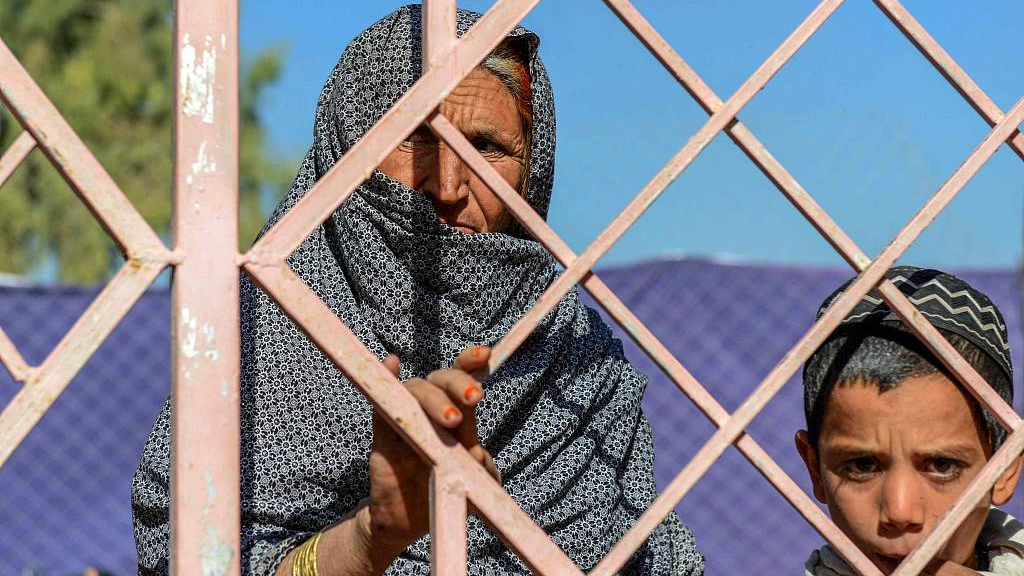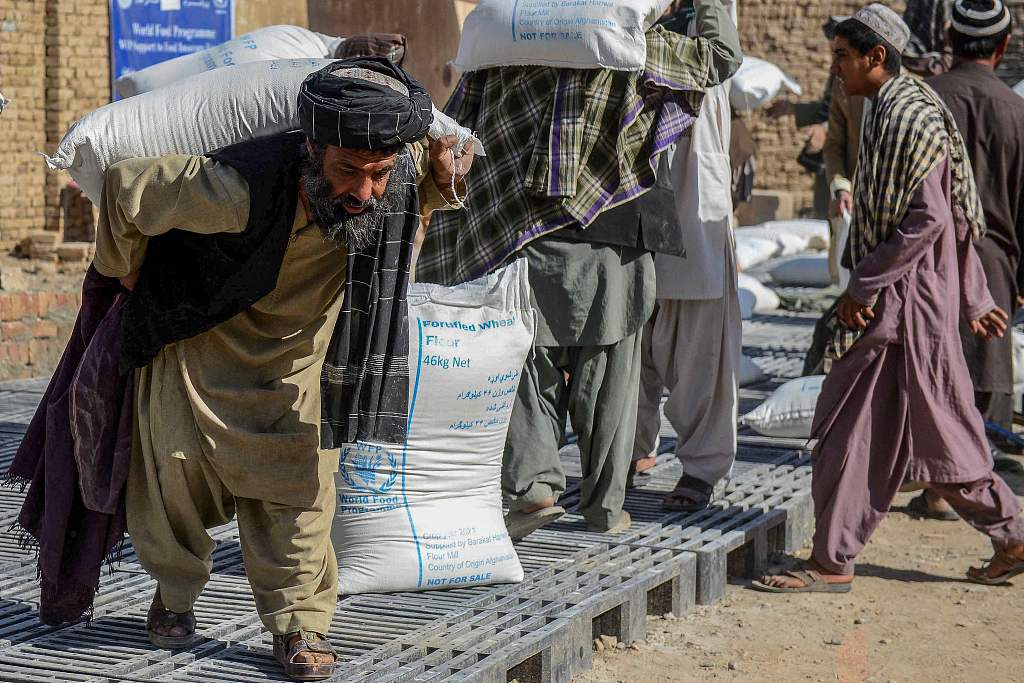
Afghan people watch as World Food Programme (WFP) volunteers distribute sacks of food grains as aid in Kandahar, Afghanistan, October 19, 2021. /CFP
Afghan people watch as World Food Programme (WFP) volunteers distribute sacks of food grains as aid in Kandahar, Afghanistan, October 19, 2021. /CFP
Editor's note: Hamzah Rifaat Hussain, a former visiting fellow at the Stimson Center in Washington and former assistant researcher at the Islamabad Policy Research Institute, is a TV anchor at Indus News in Pakistan. The article reflects the author's opinions and not necessarily those of CGTN.
"Promises cannot feed people" were the words of the United Nations Food Program Executive Director David Beasley as he underlined the rapid, unfortunate and alarming decline of Afghanistan's agricultural sector after decades of war. While the byproducts of the 20-year U.S. war include massive poverty, malnutrition, widespread displacement, terrorism and unemployment, the backbone of the Afghan national economy which is the agricultural sector has also taken a massive blow.
With roughly 80 percent of Afghans relying on it for daily sustenance and livelihood, its rapid decline can be attributed to the prolongation of war in the country and sector's abandonment after the U.S. troops' withdrawal in August.
As per assessments from the United Nations World Food Program and the Food and Agricultural Organization, Afghanistan is facing a starvation crisis, with approximately 45 percent of its population or 19 million people being at risk of high levels of food insecurity.
Years of decline and neglect of the agricultural sector during conflict and the inability to invest in the flailing sector after the withdrawal is now taking its toll as underlined by former deputy minister of Afghanistan for Agriculture and Livestock, Hamdullah Hamdard, who acknowledged that previous programs involving provision of fertilizers and watershed management vanished after September 2021.
Furthermore, years of intervention without sustainable peace and prolongation of conflicts stymied the progression of Afghan farmers to create a robust infrastructure for delivering produce internationally, which successive U.S. administrations have either chosen to ignore or have failed miserably in uplifting.
In 2021, Afghan farmers, like their conflict-torn counterparts in Sub-Saharan Africa, are enduring the pernicious effects of a second drought in four years with 7 million citizens benefiting from a harvest which is 15 percent below the world average.
The linkage between these harrowing statistics and the U.S.-led war in the country is an established fact. Firstly, high levels of crisis related insecurity during the 20-year war which entailed proxy warfare, terrorism and a refugee exodus has prevented the agricultural sector from maturing and blossoming.

Afghan people carry sacks of food grains distributed as an aid by the World Food Programme (WFP) in Kandahar, Afghanistan, October 19, 2021. /CFP
Afghan people carry sacks of food grains distributed as an aid by the World Food Programme (WFP) in Kandahar, Afghanistan, October 19, 2021. /CFP
Secondly, the prolongation of the conflict has prevented the development of a sound manufacturing base and a thriving service sector in Afghanistan resulting in Kabul retaining its status as an agrarian economy for 20 years.
Note, that public sentiment in the country regarding U.S. aid provision during the conflict has been plummeting considerably after the withdrawal, with many citizens now looking at international aid programs from the World Bank and the Asian Development Bank to fill in the vacuum left behind by respective U.S. administrations.
The damage is notable. From producers of fruits to vegetables and saffron, farmers in the country confront dwindling financial support as a result of retention of sanctions on the Kabul government which prevents probable subsidization of agriculture.
Lack of jobs and cash strapped society confronting a liquidity crisis is further exacerbating the predicament of grassroots level economic activities which forms the bedrock for countries such as Afghanistan which lack a sound secondary and tertiary base.
Beyond provision of humanitarian assistance, there has also been no concerted effort by Western countries to revive the flailing sector through targeted investments or sharing of technological best practices to boost productivity. This is despite the fact that the declining agricultural sector is disproportionately affecting Afghan children under the age of five, where 3.2 million children are expected to suffer from acute malnutrition by the end of 2021.
The Integrated Food Security Phase Classification report has also categorized the food insecurity situation in Afghanistan at levels three and four, which are "crisis level" and "emergency" level scarcities.
Truth be told, the absence of war since the 2001 intervention could have potentially ushered in greater prospects for economic prosperity in Afghanistan in the absence of political instability, terrorism and massive poverty. Yet U.S. adventurism has left behind a controversial legacy where hard cash is now needed to avert the decade-long decline of the agrarian sector.
While it is undoubtedly true that the war legacy has brought nothing but instability, poverty and malnutrition, the decaying agricultural sector which millions of Afghans rely on for survival in the aftermath of the foreign troops' withdrawal is particularly and seriously damaging.
(If you want to contribute and have specific expertise, please contact us at opinions@cgtn.com.)

